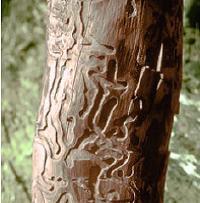Insects and Disease

Forest pests and diseases are a natural part of a forest ecosystem. While most native pests or pathogens occur at low population or infection levels, there are times when they can become epidemic. Of particular concern is watching out for introduced pests and pathogens that can cause substantial problems. Forest management can influence habitat and survival of pests and pathogens.
Forest pests and disease affect forest fuels and wildfire, by killing trees and other vegetation and making them more susceptible to ignition and severe Wildfire. Bark beetles related tree mortality has followed California's multi-year drought that began in 2010 and has been especially pronounced in the Southern Sierra Nevada where most of the affected forests are federally owned and managed. However there are many cabins on USFS leases as well as private parcels where dead trees now present public safety hazards. UC's publication on bark beetles, Bark Beetles (Seybold, Paine, and Dreistadt 2008), provides excellent information on beetle identification and control. They point out that "except for general cultural practices that improve tree vigor, little can be done to control most bark beetles once trees have been attacked." Techniques to improve tree vigor such as thinning to bring tree water use in line with available water supply and thereby reduce drought stress at the individual tree level, providing irrigation water to high value trees, involving specialists to apply behavioral chemicals in traps or repellents, and other chemical controls are described in the UCANR IPM publication.
For more background on forest pests in California forests, please see:
Forest Stewardship Series 16 - Forest Pests and Diseases.
Other UC Resources:
Bark Beetle Outbreaks in Western North American - Causes, Controls and Consequences a webinar presentation by Dr. Jodi Axelson, UC Forest Health Specialist at UC Berkeley in August 2017.
SOD Blitz - UCCE Extension Specialist in Forest Pathology Matteo M. Garbelotto has hosted an annual SOD blitz since 2008 with coordinated sampling, production of a SOD map, and public workshops on treatment of SOD. Here's how a SOD blitz works.
UCCE North Coast SOD Program - UCCE monitors for the presence of the SOD pathogen in Mendocino, Humboldt, and Del Norte Counties and is working on developing silvicultural techniques for reducing pathogen presence in forested settings.
UCCE Central Sierra hosted a series of workshops with CalFire on what to replant after unprecedented tree mortality resulting from the drought of 2012 to 2016. Materials from the workshops can be found here. They also developed a tree mortality toolkit to help UC Master Gardeners answer questions from the public about dying trees.
UC IPM Pest note on the Gold Spotted Oak Borer found in southern California and information on research into that exotic pest.
Pests of Native California Conifers - This book is also an excellent resource https://www.ucpress.edu/ebook.php?isbn=9780520936379 (order)
Other Resources:
The CalFire 2017 Forest and Rangeland Assessment Report has a chapter which describes forest pests and other threats to ecosystem health and community safety in California.
CalFire put out issues of the Forestland Steward Newsletter on the unprecedented tree mortality in the state in 2016.
Some current forest pests of concern in California are:
- Sudden Oak Death (SOD) www.suddenoakdeath.org,
Identification of forest insects can be tricky. Check out the following websites for descriptions and photos of insects:
- http://www.forestpests.org/
- http://www.forestryimages.org/insects.cfm
- http://www.forestpathology.org/index.html
CALFIRE pest specialists - They help protect the state's forest resources from native and introduced pests, conduct surveys and provide technical assistance to private forest landowners, and promote forest health on all forest lands.
The US Forest Service Forest Health Protection (FHP) program - FHP is responsible for technical assistance for forest health activities; monitoring and reporting on the health of all forest lands in the Pacific Southwest Region. They work in partnership with the National Forest System, other federal agencies, states, Native American tribes and the private sector, to provide assistance, knowledge and forest health information. FHP has specialists in: forest pathology; forest entomology; pesticide use and safety; remote sensing and geographic information systems.
County Agriculture Commissioners - Each California county has an agricultural commissioner that can assist with identification of insects identification, appropriate pesticides. Commissioners also regulate pesticide use and can provide information on safe and effective use of pesticides.
California Forest Pest Council - The Council (CFPC) fosters education concerning forest pests and forest health, and advises the California Board of Forestry and Fire Protection on forest health protection. They host annual meetings and field trips for forest managers, forest pest specialists, policy makers and analysts, government agencies and anyone interested in forest health.
Forest Health and Carbon Storage in the Sierra Nevada - System Indicators: A final report to the Sierra Nevada Conservancy, December 2012. This reports on the status of Sierra Nevada forests from the standpoint of health, fire and carbon storage.
Maps
For maps of aerial surveys done by the USFS Forest Health Protection (FHP), see: http://www.fs.fed.us/r5/spf/fhp/fhm/aerial/draft/index.shtml
